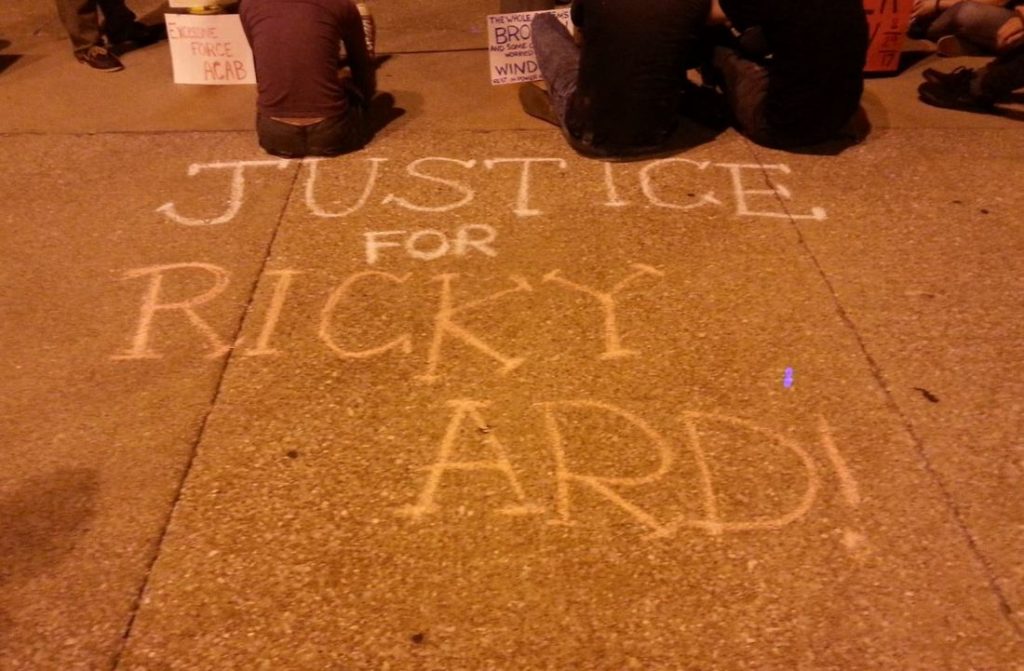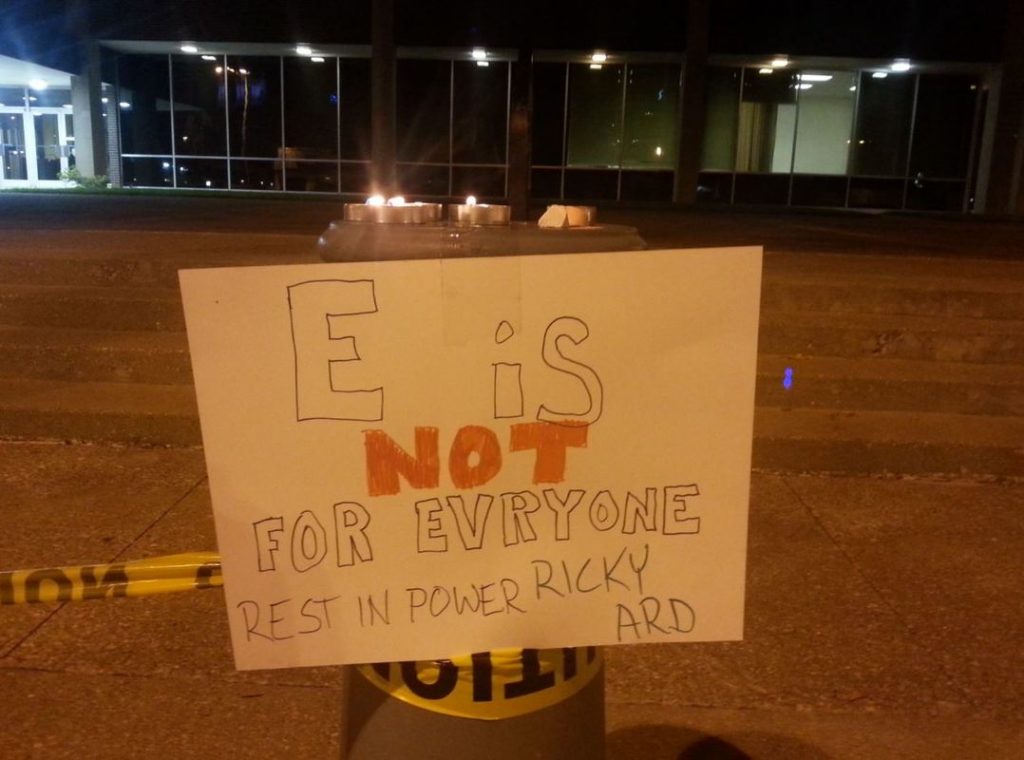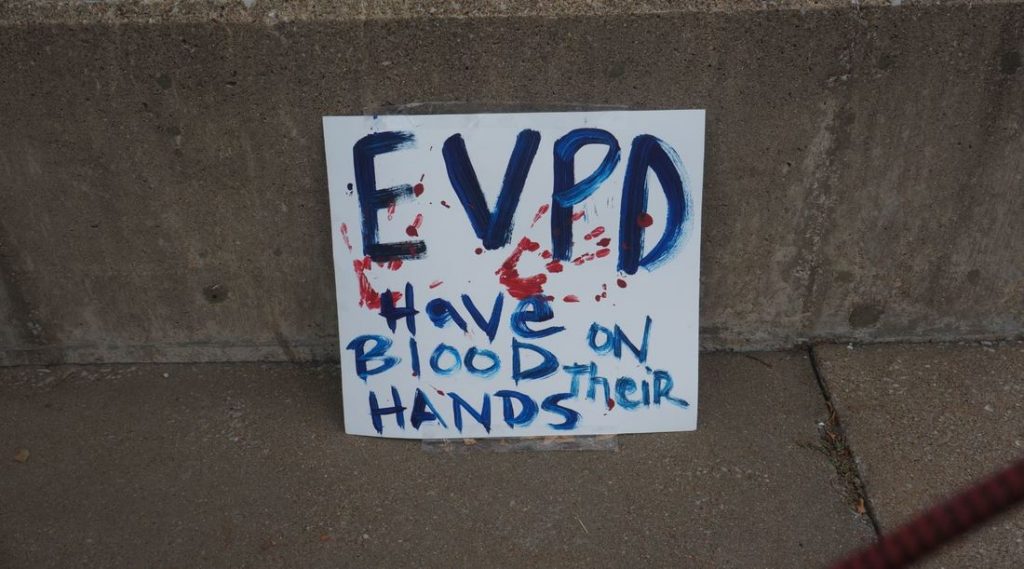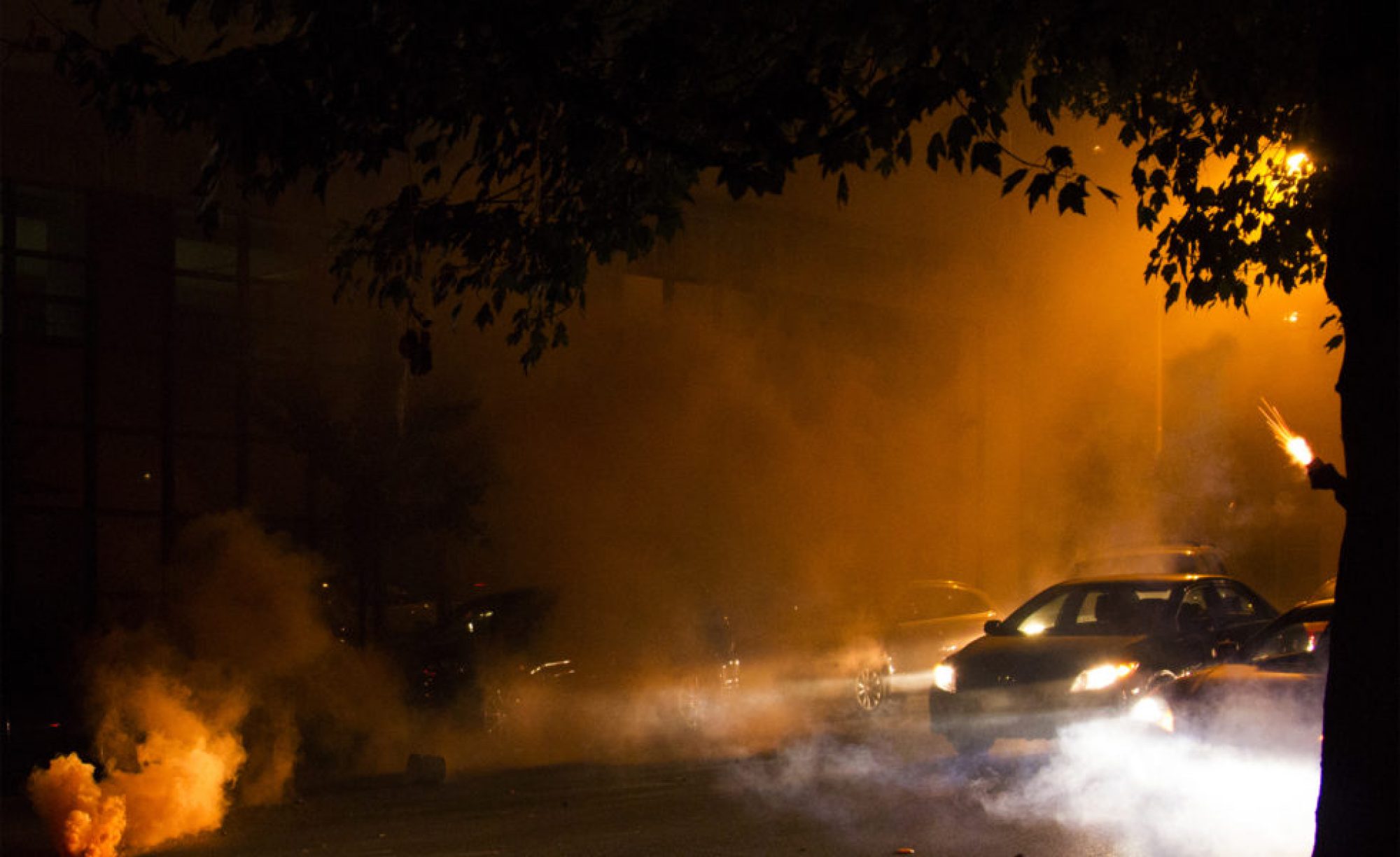In August of 2017 Evansville, Indiana resident Ricky Ard was gunned down by an EPD officer and a federal security guard outside of the federal courthouse in downtown Evansville. We spoke with three people involved in the response to Ricky’s death.

Can you start by walking us through what happened at the Denton Federal Building on August 29th?
Respondent 3: Ricky Ard is reported to have gone to the Federal Building the day before he was killed to “complain about the government.” He was removed from the building without incident. He returned the next day with a bat, shouting at the building and broke some of its windows. Ricky retreated away from the building and sat down for several minutes before walking toward the building a second time. EPD officer Kenny Dutschke approached him from behind, shouted orders and deployed his taser, which was “ineffective” according to a police statement. Ricky responded to the officer’s aggression by swinging his bat and moving toward the officer. Dutschke and a federal security guard whose name has not been released shot Ricky Ard 6 times, bringing him to the ground and killing him.
What was the response?
Respondent 3: Ricky was murdered around 11 a.m. The mainstream media covered the story pretty immediately. A friend heard about it and sent out a text. People in our neighborhood were talking about the police shooting and killing someone at the Federal Building. People were saying that his body was still laying there and asking, “what are we going to do about it?!” We began checking all the coverage and our facts, and several people went to the location to get more insight. I mentioned we have to be there tonight, to not let this go without challenge or notice if nothing else for his family. We met up in the early evening, piled up supplies for posters and a vigil, shared our plan with other neighbors and decided to act after sundown. Almost twenty of us met and occupied in front of the Federal Building where they had washed away all evidence anything had happened. Throughout the night, about sixty people trickled through. We lit candles and spread our signs along edge of the property and scratched messages in chalk along the sidewalks; we talked and sat and waited.
Why did you join the gathering at the Federal Building?
Respondent 2: Some friends and I gathered at my house on the evening of Ricky’s murder to try to figure out how to respond. One other person and I were trying to say that we should wait until the next day to hold some kind of demonstration in hopes of doing more planning and having a bigger turnout. Another friend showed up who perhaps tends more toward action and made it clear that she was going to be down at the federal building that night and that we could choose to join her or not. In retrospect, I am really appreciative of that person’s tenacity, as the vigil that night ended up being really inspiring for me and attracted a fair amount of others who were upset about what the cops had done and wanted or needed to be around others who felt the same way. For me, my choice to go down to the federal building came from at least two places within me. First, it came from an ideological or strategic place that seeks out certain moments of conflict because I believe them to be opportunities to push ideas about how I’d like the world to be. Second, it came from a more emotional place that wanted to mark in time the death of a mentally ill old man at the hands of a pig with too much power. I had gone down to the federal building earlier that day, shortly after Ricky was murdered and the clean up crew had already hosed his blood off the cement. All that was left was a wet spot to indicate his murder and a broken window that a security guard was casually leaning through, joking with a co-worker. It really is true that some people are considered disposable by society and that makes me feel like shit. I don’t want to live in despair, nor do I want to feel isolated in my suffering. So getting together with others, yelling at some shitty exploitative reporter, taking neighbor kids down there and talking to them about what happened gave me a way to move through it and hopefully honor Ricky’s death.

Since Ferguson, cops in many places get very nervous about a response to police murders, sometimes resulting in very heavy handed policing, and others with very intricate soft-policing. How did the Evansville PD respond to those who had gathered?
Respondent 3: Within 10 minutes police cars were driving back and forth in front of the building, slowing down scanning us, and parking across from the building and on all sides. They made no contact with us at the vigil. At a small rally the next day, a Federal Officer verbally reinforced where the property lines of the building were and instructed that any trespass would end in arrest. When a protester asked about the public sidewalk the officer rushed into his face and physically flexed up, telling the protester not to challenge him. When cameras were brought out he backed down and shielded his face.
Respondent 2: In general, our collective response to Ricky Ard’s murder was not powerful enough to elicit much of a repressive response. On the night of his murder, we held a candlelight vigil and the next day we gathered on a public sidewalk outside of the federal building where the police and press outnumbered us by a significant margin. This is not to say that these moments were not powerful for those involved and for the Ard family viewing them from afar, nor that they weren’t a powerful gesture in a place where so little seems to be possible. But it does seem important to point out that it is too soon to make accurate calculations about how repressive forces like cops and the criminal justice system would respond to a powerful counter-force. Nonetheless, as indicated above, the federal agents who confronted us on the sidewalk the day following Ricky’s murder responded aggressively to the smallest challenge, indicating that if the conflict were to have advanced, they would have quickly escalated to heavy-handed measures rather than more diplomatic de-escalation.
Has there been any sustained organizing in the months following Ricky’s murder?
Respondent 3: Where the River Frowns covered the story live and with an immediate critical nature against the police procedure and response. We gathered the next morning and all of our posters, messages, and candles had been removed. So we replaced them. Some of us spoke with the news media who wanted more answers from concerned outspoken citizens than from the police who killed Ricky. Where the River Frowns maintained communication with the family who reached out to them after the coverage was shared via Facebook, and they diligently kept the tact and message from the family the top priority. There is effort to revisit this event and our actions, as well as continue to examine the police’s response afterwards in a zine. WTRF took the participating neighbors’ and attendees’ perspectives and intel objectively and allowed me to critique and add my thoughts without me having a personal podium to otherwise do so.
Respondent 2: After our attempt at a demonstration in front of the federal building on the day following Ricky’s murder was so sparsely attended, the response quickly lost momentum. On the night of the vigil some people who attended indicated that they were going to show up the next day with significant numbers of people in tow, but those people did not manifest. There were some efforts among the group of friends who planned the vigil to continue to act, but ultimately we could not maintain the momentum, nor could we transform it into longer-lasting projects. The reasons for this are many, but some of them are our own inexperience in working together and, for most of us, our inexperience in responding to these kinds of situations. Additionally, we are trying to make things possible in a really inhospitable environment, with very little recent precedent for rebellion and very little participation in the social movements of the last few years (the local resistance to the construction of I-69 being a notable exception). In general, we are still trying to figure out what a response to a police murder (for example) looks like here and how we could work together to make that happen. Ricky Ard’s murder was the first recent catalyst for us attempting to work out some answers to those questions and I think it did leave us a little closer to doing so.
What seems to have changed in Evansville since then? How has it affected neighborhoods and groups of people within Evansville?
Respondent 3: No direct correlation has been made, but one group, MASK (Mothers Against Senseless Killings), formed recently whose mission is to be directly involved in neighborhood patrols and police intervention. They proclaim to be taking their city back and giving their community more options than calling the police. I believe this is due to a culmination of the last few years being policed heavily and wanting to to collectively acknowledge how they are being singled out and falling into systemic carceral trappings/pipelines.

What reflections do yall have on the aftermath of Ricky’s murder?
Respondent 1: I’m glad that we held the vigil on the day of Ricky’s murder. I think it allowed people who watch the news to see opposition to police brutality, and it created a space for some people to come to talk about what had happened. I think it was meaningful to Ricky’s family as well. A lot of us were really worn out though by the time the body camera footage was released two days later. We had been at the vigil, creating media, writing and printing a statement to hand out at a rally, contacting the family, etc., so we ran out of energy around the same time that the surveillance and body camera footage was released. I’m afraid that sent a message that we were satisfied with the police narrative of “appropriate” force; I wish would would have continued to visibly oppose what had happened in some way.
One of the most heartbreaking aspects of police murders is seeing the families of the victims on what has to be one of the worst days of their lives. How did yall approach the family and navigate building those relationships?
Respondent 2: Our interactions with the family were pretty minimal. At the vigil on the night of the murder, a woman who attended said she was in touch with the family and I approached her and asked if she would pass on my number. A couple days later I got a text from Shannon, Ricky Ard’s niece, and we arranged to talk. It was hard to balance my desire for her and her family to take certain positions–such as condemning police violence or calling for protests–with the obvious need to put her grieving process first. It took an effort to put our shared humanity before my ideology. I made myself available for more connection, invited her to collaborate on an interview to be published on Where the River Frowns and asked about the possibility of more public protests. She seemed uninterested in these things, but was kind and thanked us for the vigil. She said that she appreciated how “diverse” the vigil had been–highlighting the number of both Black and white people in attendance. That was the only real contact we had with her until she sent us and the mainstream media the same statement a couple days later. I wish that more relationship building had been possible, but it didn’t seem to be in this case.
A statement from Ricky’s niece, Shannon, talks about Ricky’s history of mental illness. Here in Bloomington, data from the BPD shows that most situations in which officers drew weapons were Wellness Checks, indicating that those struggling with mental health are some of the most at-risk for police abuse and violence. Can yall talk about how you see mental illness factoring in to the danger that police pose? How has that thread been woven into the local response?
Respondent 3: I see mental illness used by authorities to override all autonomy or cognitive reductive capacity from their suspect and then to self-impose their own protocol or desired interaction without context. The police department is quoted as saying the officer that killed Ricky Ard acted within acceptable defensive procedure and that the video footage and response could be used in future trainings. The re-elected Sheriff’s new jail being marketed as a mental health facility proposal is the city’s response.
Respondent 2: In September, 2016, police executed a homeless man named Daniel Wooters after he jumped in an unattended a police cruiser and drove off. Previous arrest records indicate that he probably suffered from severe mental illness. In October, 2016, Evansville police brutally beat a handcufffed homeless drug addict, Mark Healy, after a cop stuck himself on a syringe in Healy’s pocket. The issue evoked controversy after body camera footage proved the cops had concocted a bullshit story together for the police report. In August, Ricky Ard was murdered despite obviously needing mental health intervention and when de-escalation strategies could have easily been employed. The homeless, the addicted, the mentally ill. Its obvious that Evansville police, like police elsewhere, respond with violence in situations when people most need help. Unfortunately, the brevity of our response did not allow us to put a strong focus on this aspect of Ricky’s murder, despite requests by his family that we do so.
There have also been a number of police murders in Indianapolis including Andre Green, Mack Long, and Christopher Goodlow in 2015; Aaron Bailey in June of 2017. Bradley King, who, according to his family, had schizophrenia, was killed by a Hendricks County Sheriff deputy in 2016. Rarely are there any consequences for the officers or departments responsible. How could we be working together across the state for a stronger response?
Respondent 3: Stringing these deaths and misconducts together as evidence of a systemic failure would greatly bring light to each as a social crisis rather than bad apples. Sharing each other’s newsletters, speaking about local crimes statewide, drawing out the ties between law enforcement and mass incarceration, getting involved in prison abolition, collectively sharing the responsibilities to get word out about these events, and encouraging and supporting each other could be steps toward higher consequences for police who kill people.
Respondent 2: I would like to see greater contact and collaboration between people in this region in hopes of establishing more complex networks that could, among other things, be relied upon to facilitate a rapid response to a police murder. In these moments, it’s useful if we can act fast and respond in large numbers. If those who were interested in pushing back against police violence were in touch with each other throughout the region, we could go to each other’s towns and create a significant disturbance in these moments. I think the only way we are ever going to stop police violence is if we make it clear that our towns and cities aren’t going to function if the cops keep killing people. Creating major disturbances that shut down freeways, close businesses, cause damage to state and corporate property and otherwise make sure we can’t all just go about our day, takes large numbers of people. If we help each other we increase our chances of achieving that. In the moments when there isn’t a heightened conflict, we can use these networks to build, share resources, and attempt to improve our lives and the lives of those around us.
The calls for officers to be fired or have criminal charges brought against them almost always end in cruel disappointment. With so many strategies failing to hold police accountable, what thoughts do you have about novel ways to address police violence?
Respondent 3: Not shielding their actions as a police officers from their daily lives–their neighbors, pastors, families, etc.–might be effective. The security guard’s name still hasn’t been released. He clocks in and kills someone, clocks out and no one knows who this person is.
Respondent 2: I addressed this question in my answer above, but I’d like to add that if we can get together with those around us and build up the strength of our neighborhoods and communities so that more and more we are turning to each other to solve problems and mediate conflict, the police and other powerful actors in society will have less and less of an impact on our lives. Obviously, we’re a long way from that, but I think it’s useful to hold this as a direction in which we can point in our efforts. Any time someone on our block calls a neighbor or friend instead of the police, we reduce the chances of somebody ending up dead or in jail. Also, a lot of crime, anti-social violence and moments of police intervention are linked to people not having their needs met in some way. The more we are getting ourselves together to feed, clothe and house each other, support each other through domestic disputes and other conflicts, respond to each other’s medical problems as well as we can, meet each other’s social and emotional needs, get together to defend ourselves and each other both with and without weapons, the more we can avoid bringing cops and other destructive forces into our lives and the less we’ll have to worry about whether the cops are reforming themselves, wearing body cameras or whatever nonsense they come up with. Obviously the cops would still be in our lives, but if we were better organized to meet our own needs we’d be better situated to powerfully respond to their intrusions.

For people who have no faith in police reform, what hopes might they have for participating in protests of police violence? Is there a hope for a more generalized and uncontrollable revolt like we saw in Ferguson or Baltimore? If so, how might one intervene to that end? If not, what else motivates or guides one’s participation?
Respondent 3: The more we pay attention, take on serious engagement and educate ourselves, the more we can replace the need for these institutions in our daily lives. We only have spirit and numbers on our side.
Respondent 2: In a context like Evansville, it seems unlikely that we can expect a response that resembles even a scaled-back version of what happened in Ferguson or Baltimore. Therefore, it’s necessary to think about what is possible in our context and not try to replicate those events in a context where they don’t apply. Small disturbances do seem possible in Evansville and the more of a ruckus we can create, the more effective we will be. That being said, even small gestures such as the vigil we held have a huge impact on the way we consider what is and is not possible in a place and can build our capacity in ways we can’t fully predict. I think for a lot of people seeing a diverse crowd of people acknowledging that someone was murdered and standing up to his murders even in small ways was very meaningful. We can build from there. In my opinion, change is slow and even explosive moments of concentrated progress like we saw in Ferguson are the result of consistent and unpredictable contributions of innumerable forces over time. We can’t go out in the streets expecting Ferguson, but we can act knowing that we are carrying on the legacy of those who acted in Ferguson and creating another tiny, interstitial moment that, in combination with other moments like it, has the potential to build to something bigger. There is no certainty that our efforts will lead to any particular outcome and proceeding anyway requires patience and humility. Fortunately, cultivating those qualities also make one’s life better in the meantime.
Anything else you’d like to share?
Respondent 1: On February 23, 2018, EPD officer Samuel SeDoris shot and killed 59-year-old Evansville resident Douglas Kemp during a traffic stop. Kemp was the 182nd person killed by police in 2018, and the second person killed by the EPD in less than 6 months. A month before, on January 18, 2018, EPD officer Jackie Smith fired two shots at Vincent Bufkin while responding to a “refusal to leave” call; Bufkin survived a gunshot wound to his shoulder. Last year, officers Nick Henderson, Mark DeCamps and Marcus Craig attacked a handcuffed Mark Healy and fabricated an alternative story about it, which Sergeant Kyle Kassel approved. Two years ago, officers Jason Thomas, Zach Elfreich and Dexter Wolf shot Daniel Wooters who was thirty feet away from them, “armed” with a knife and not making any advances. These 9 officers, like officer Kenny Dutschke and the unnamed security guard who killed Ricky Ard, ultimately faced no charges, disciplinary actions, or other obvious consequences. Unfortunately, Ricky Ard’s murder is not an isolated incident, and clearly police are not holding themselves accountable for their violence.
Respondent 2: On the night of Ricky’s murder, many of us who went down to the federal building sent texts out to most of our friends in town asking them to come. One of the most inspiring responses came from a friend who was running a Dungeons and Dragons campaign that night who convinced his whole group to cancel whatever kind of dragon slaying they were up to and come down to the vigil.
We thank these respondents for sharing their thoughts and experience with us, appreciate everyone who showed up in the wake of Ricky’s murder, and send our best to Ricky’s family and friends. Check out Where the River Frowns for more on this story and many others.
